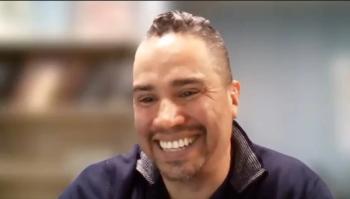
Adding Ibrutinib to FCR Combo Shows Promise as Time-Limited Therapy in Younger Patients With CLL
The time-limited combination of ibrutinib plus chemoimmunotherapy in younger fit patients with chronic lymphocytic leukemia increased the rate of complete responses with bone marrow undetectable minimal residual disease, regardless of IGHV mutation, according to long-term follow-up data.
After a median follow-up of 40.3 months, the addition of ibrutinib (Imbruvica) to fludarabine, cyclophosphamide, and rituximab (Rituxan), or iFCR, increased the rate of complete responses (CRs) with bone marrow undetectable minimal residual disease (BM-uMRD) to 55% in younger fit patients with chronic lymphocytic leukemia (CLL), according to long-term data from a phase 2 study presented at the
Moreover, these results included patients with unmutated IGHV, a population who rarely has durable responses, according to Matthew S. Davids, MD, MMSc.
“Other studies have suggested that patients treated with ibrutinib-based therapy have variable benefits, even with IGHV-unmutated disease. However, we have not seen larger data yet for the combination of ibrutinib with FCR,” Davids, director, clinical research, Division of Lymphoma at Dana-Farber Cancer Institute and an associate professor of medicine at Harvard Medical School, said during a presentation of the data. “We hypothesized that combining ibrutinib with FCR as initial therapy would lead to a high rate of CR with BM-uMRD in a broad population of younger, fit patients [with CLL].”
The median number of ibrutinib maintenance cycles was 24 (range, 0-81). In the intent-to-treat (ITT) population, the rate of CR with BM-uMRD improved to 55% (n = 47), and the best rate of BM-uMRD remained at 84% (n = 71). The CR rate deepened with ibrutinib maintenance therapy, from 34% to 81% as the best rate. This was similar among the IGHV-mutated and -unmutated patients, up from 41% to 88% and up from 28% to 76%, respectively, as the best rates. Lastly, the BM MRD-negative rates in the ITT population were 91% in the 81 patients with the TP53 mutation.
With time-limited novel agent plus chemoimmunotherapy, 3-year progression-free (PFS) and overall survival (OS) rates were 97% and 99%, respectively. Thirteen patients (21.3%) who discontinued ibrutinib have had recurrent BM-MRD, including 5 patients with clinical progression of CLL. Seven patients restarted treatment with ibrutinib, all of whom have experienced partial responses. The median time on re-treatment is 12.8 months (range, 4.2-26.2).
In the updated safety analysis, the most common grade 3/4 treatment-emergent adverse effects (TEAEs) were hematologic, including neutropenia (40%; up from 35%), thrombocytopenia (32%; unchanged), and anemia (11%; unchanged). Additional serious AEs included grade 3 or higher febrile neutropenia (12%; up from 9%) and infection (24%; up from 11%). Moreover, any grade atrial fibrillation was observed in 8% of patients (up from 3.5%). Two patients developed myelodysplastic syndrome, but both are now in CR for CLL and MDS after undergoing allogenic transplant. No patients developed Richter’s syndrome.
“We believe iFCR is worthy of exploring in comparative studies in a broad population of younger, fit CLL patients with intact TP53 who desire the possibility of functional cure with time-limited therapy,” Davids said.
In the multicenter, open label, non-randomized, single arm, phase 2 trial (NCT02251548), 85 patients with CLL, aged ≤65 years without restriction by IGHV mutation status and who met iwCLL treatment criteria were enrolled at 7 US sites from October 2014 and April 2018.
Patients received 420 mg ibrutinib daily for 7 days, followed by six 28-day cycles of the combination: 420 mg ibrutinib daily, 25 mg/m2 fludarabine on days 1 to 3, 250 mg/m2 cyclophosphamide on days 1 to 3, and 375 mg/m2 rituximab on day 1 of cycle 1 and 500 mg/m2 on day 1 of cycles 2 to 6.
Those who responded to therapy continued on maintenance therapy with ibrutinib, and those with BM-uMRD after 2 years of maintenance discontinued therapy.
The rate of CR/CRi with BM-uMRD at 2 months following treatment with the iFCR combination served as the primary end point. Secondary end points included response rates, PFS, OS, rates of BM-uMRD after 2 years of ibrutinib maintenance, and safety/tolerability.
The median age at enrollment was 55 years (range, 38-65). IGHV was unmutated in 46 patients (58%), and deletion of 17p (n = 4), 11q (n = 17), and 13q (n = 45), as well as trisomy 12 (n = 14), TP53 mutations (n = 3), and NOTCH1 mutations (n = 5) were also present. The median number of FCR cycles completed was 6 (range, 1-6).
In the initial safety and efficacy results, median follow-up was 16.5 months (range, 10.6-34.1).2
A CR with BM-uMRD 2 months after the last cycle of iFCR was achieved by 28 patients (33%; 95% CI, 0.23-0.44; P = .0035). A best response of BM-uMRD was achieved by 71 patients (84%).
One patient had disease progression and one patient died from sudden cardiac death after 17 months of ibrutinib maintenance.
The most common all-grade AEs were hematological, including thrombocytopenia (74%), neutropenia (62%), and anemia (49%). Grade 3 or 4 non-hematological serious AEs included grade 3 atrial fibrillation (4%) and grade 3 Pneumocystis jirovecii pneumonia (2%).
References
- Davids MS, Brander DM, Tyekucheva S, et al. Longer term follow-up of a multicenter, phase 2 study of ibrutinib plus fludarabine, cyclophosphamide, rituximab (iFCR) as initial therapy for younger patients with chronic lymphocytic leukemia. Presented at 2021 ASH Annual Meeting and Exposition; December 11-14, 2021; Atlanta, Georgia. Abstract 640.
- Davids MS, Brander DM, Kim, HT, et al. Ibrutinib plus fludarabine, cyclophosphamide, and rituximab as initial treatment for younger patients with chronic lymphocytic leukaemia: a single-arm, multicentre, phase 2 trial. Lancet Haematology. 2019;6(8):419-428. doi:10.1016/S2352-3026(19)30104-8.
Newsletter
Stay up to date on recent advances in the multidisciplinary approach to cancer.






